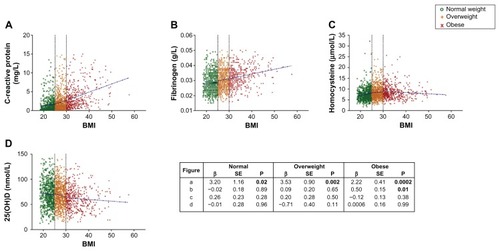Figures & data
Table 1 Population characteristics
Figure 1 Relationship between metabolic markers and BMI by BMI group.
Abbreviations: BMI, body mass index; HbA1c, glycosylated hemoglobin; LDL-C, low-density lipoprotein cholesterol; HDL-C, high-density lipoprotein cholesterol; Total:HDL-C ratio, total cholesterol/HDL ratio; SE, standard error.

Figure 2 Relationship between BMI and biomarkers of inflammation and plasma vitamin D by BMI groups.
Abbreviations: BMI, body mass index; 25(OH)D, 25-hydroxyvitamin D; CRP, C-reactive protein; SE, standard error.

Table 2 Adjusted mean levels of biomarkers by BMI groups